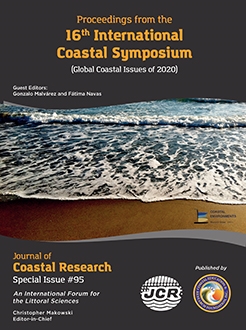Martinelli Filho, J.E.; Colwell, R.R.; Queioz, A.F.S.; Rivera, I.N.G., and Lopes, R.M., 2020. Vibrio cholerae O139 attached to zooplankton: Reservoir diversity and distribution over an estuarine-coastal gradient. In: Malvárez, G. and Navas, F. (eds.), Global Coastal Issues of 2020. Journal of Coastal Research, Special Issue No. 95, pp. 92-96. Coconut Creek (Florida), ISSN 0749-0208.
Some Vibrio cholerae strains are potentially pathogenic and harmful to humans, most belong to toxigenic serogroups O1 and O139. These bacteria have many natural reservoirs and are frequently found attached to phytoplankton and zooplankton. However, the dynamics of the association between V. cholerae and zooplankton and the distribution of V. cholerae over coastal and estuarine waters and between the many biological reservoirs has proven to be of interest. Zooplankton comprise a highly diverse community and V. cholerae is known to attach mainly on crustaceans, although serogroup O1 may colonize diverse planktonic taxa including foraminiferans, polychaete larvae, and fish eggs. In order to understand the distribution of V. cholerae O139 in coastal areas and the diversity of potential zooplanktonic reservoirs, the presence of the bacterium on 43 taxa from 9 distinct phyla over an estuarine-coastal gradient in the southeast Brazilian coast was investigated during July 2005 to March 2006. Plankton was collected with a 300µm mesh net, which was washed onboard between each tow. Detection of V. cholerae O139 was assessed in whole samples and for selected taxa by DFA and DVC-DFA (Direct Fluorescence Assay and Direct Viable Count) methods. V. cholerae O139 was present in most of the estuarine samples (77%), being less common on inner shelf samples (63%) probably due to higher salinity, although a larger sampling design would be needed to test this hypothesis. Our findings suggest the occurrence of an inshore-offshore gradient for V. cholerae O139 distribution in zooplanktonic reservoir, as well as new sites for V. cholerae O139 attachment, like echinoid larvae, appendicularians, and thaliaceans. Monitoring these bacteria in cholera outbreak areas should include analyses of planktonic communities, since that may be an important natural reservoir and would ensure safety of coastal urbanized areas.





